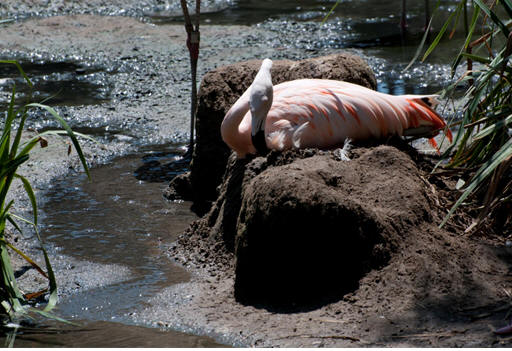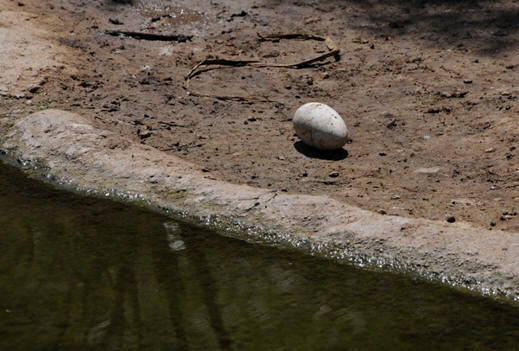How do Chilean flamingos reproduce?
For Phoenicopterus chilensis,
reproduction is not a large part of their life cycles. On
average, the Chilean flamingo only reproduces once every 3.64
years. In a 41 year study that was performed, only 11 successful
attempts at reproduction were made (Bucher et al. 2012). In
order to be considered an attempt at reproducing, the male
flamingo must mount and balance on the female for at least three
seconds. This is the males attempt at making cloacal contact
with the female (King 1994). The reason why these flamingos
have a low average of reproducing is because the males have a
hard time keeping balanced on the females, and they end up
falling off of the back of the female (King 1994).
In their semi-arid, subtropical
ecosystem, the presence of mudflats,
which is a muddy area next to the shoreline when the tide is
low, is a necessity (Studer-Thiersch 2000). Other conditions
that affect breeding periods are the availability of food.
Chilean flamingos delay their reproduction until the conditions
are just right (They breed in large colonies on the shorelines of
salt lagoons and soda lakes (Bildstein et al. 1993). While
other birds mate with one singular individual for their life,
this breed of flamingos have the choice each time they reproduce
to pick a different mate.
During the reproduction period, the
Chilean flamingo has different group options for reproduction
partners. The flamingos either group up in the traditional one
male and one female partnership, or stay in larger groups of
either 3 birds or more (Bildstein et al. 1993). To claim the
flamingo they choose to reproduce with, they perform aggressive
acts to preserve their relationship and to show others that they
are paired (Bildstein et al. 1993). This ties in with the aggressive interactions
this type of flamingo have with one another.
When the mother gives birth to a flamingo, it is not a live
birth. The chick incubates in an egg for 27-31 days before it
hatches. Both the mother and the father take turns incubating
the egg. There is no distinct difference in the amount of time
each parent incubates for (Barry et al. 2000). Reptiles are
other animals whol lay eggs when they give birth. One example is
the
Northern California Aligator Lizard. When born, the
chick has grey feathers (Woodland Park Zoo 2014). It also has a
straight beak, which will curve down throughout maturity (Woodland
Park Zoo 2014).
While at this young age, chicks gather in “chéches”, which is a
very large group of young flamingos that are watched by a few
adults from the pack (Woodland Park Zoo 2014). It is almost like daycare for
flamingos.
At about 10-12 weeks of age, their formed straight beak allows
them to fully digest their food now (Woodland Park Zoo 2014).
These birds grow up very quickly. At 6-10 months, their feathers
start to change into the distinctive color of a flamingo, light
pink (Woodland Park Zoo 2014). Just shortly after being alive for one year, they
are starting to have light pink feathers mixed in with brown and
grey patches (Woodland Park Zoo 2014). They are fully pink by two to three years
of age (Woodland Park Zoo 2014). By age three to five, they are sexually mature
adults and ready to attempt reproduction with a mate they choose
from their pack of flamingos (Woodland Park Zoo 2014).

